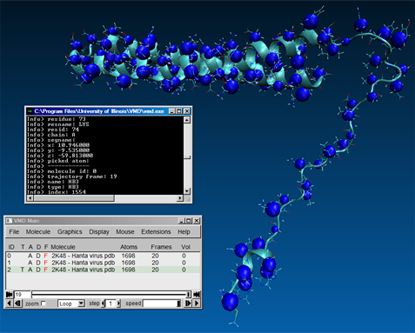 "The hanta viruses are emerging infectious viruses that in humans can cause a cardiopulmonary syndrome or a hemorrhagic fever with renal syndrome. The nucleocapsid (N) is the most abundant viral protein, and during viral assembly, the N protein forms trimers and packages the viral RNA genome. N1-74 forms two long helices (alpha1 and alpha2) that intertwine into a coiled coil domain. The conserved hydrophobic residues at the helix alpha1-alpha2 interface stabilize the coiled coil; however, there are many conserved surface residues whose function is not known"
Extracts from a citation by: Wang, Y., Boudreaux, D.M., Estrada, D.F., Egan, C.W., St Jeor, S.C., De Guzman, R.N.
Downloaded from the Protein Data Bank, and visualized with VMD.
Why is this so important? The Lujo virus, a newly identified viral heamorrhagic fever, was recently identified in South Africa after a fatal outbreak of the disease in Johannesburg. Use of tools such as NAMD and VMD can assist scientists in understanding the behaviour of these organisms and hopefuly determine methods to combat them.
"The hanta viruses are emerging infectious viruses that in humans can cause a cardiopulmonary syndrome or a hemorrhagic fever with renal syndrome. The nucleocapsid (N) is the most abundant viral protein, and during viral assembly, the N protein forms trimers and packages the viral RNA genome. N1-74 forms two long helices (alpha1 and alpha2) that intertwine into a coiled coil domain. The conserved hydrophobic residues at the helix alpha1-alpha2 interface stabilize the coiled coil; however, there are many conserved surface residues whose function is not known"
Extracts from a citation by: Wang, Y., Boudreaux, D.M., Estrada, D.F., Egan, C.W., St Jeor, S.C., De Guzman, R.N.
Downloaded from the Protein Data Bank, and visualized with VMD.
Why is this so important? The Lujo virus, a newly identified viral heamorrhagic fever, was recently identified in South Africa after a fatal outbreak of the disease in Johannesburg. Use of tools such as NAMD and VMD can assist scientists in understanding the behaviour of these organisms and hopefuly determine methods to combat them. "The hanta viruses are emerging infectious viruses that in humans can cause a cardiopulmonary syndrome or a hemorrhagic fever with renal syndrome. The nucleocapsid (N) is the most abundant viral protein, and during viral assembly, the N protein forms trimers and packages the viral RNA genome. N1-74 forms two long helices (alpha1 and alpha2) that intertwine into a coiled coil domain. The conserved hydrophobic residues at the helix alpha1-alpha2 interface stabilize the coiled coil; however, there are many conserved surface residues whose function is not known"
Extracts from a citation by: Wang, Y., Boudreaux, D.M., Estrada, D.F., Egan, C.W., St Jeor, S.C., De Guzman, R.N.
Downloaded from the Protein Data Bank, and visualized with VMD.
Why is this so important? The Lujo virus, a newly identified viral heamorrhagic fever, was recently identified in South Africa after a fatal outbreak of the disease in Johannesburg. Use of tools such as NAMD and VMD can assist scientists in understanding the behaviour of these organisms and hopefuly determine methods to combat them.
"The hanta viruses are emerging infectious viruses that in humans can cause a cardiopulmonary syndrome or a hemorrhagic fever with renal syndrome. The nucleocapsid (N) is the most abundant viral protein, and during viral assembly, the N protein forms trimers and packages the viral RNA genome. N1-74 forms two long helices (alpha1 and alpha2) that intertwine into a coiled coil domain. The conserved hydrophobic residues at the helix alpha1-alpha2 interface stabilize the coiled coil; however, there are many conserved surface residues whose function is not known"
Extracts from a citation by: Wang, Y., Boudreaux, D.M., Estrada, D.F., Egan, C.W., St Jeor, S.C., De Guzman, R.N.
Downloaded from the Protein Data Bank, and visualized with VMD.
Why is this so important? The Lujo virus, a newly identified viral heamorrhagic fever, was recently identified in South Africa after a fatal outbreak of the disease in Johannesburg. Use of tools such as NAMD and VMD can assist scientists in understanding the behaviour of these organisms and hopefuly determine methods to combat them.